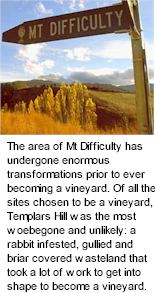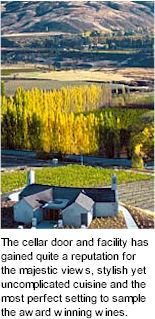


Mt Difficulty owns some of the oldest vineyards and is one of most respected wineries in the Central Otago region of New Zealand's rugged South Island. The joint venture company, founded by some of Central Otago's most devoted and skillful growers, has grown into a leading New Zealand boutique winery with export markets everywhere.

Mt Difficulty really is a boutique estate, situated in Bannockburn, a unique and rare area of extremes. Mt Difficulty has harnessed the once brutal terrain to produce premium wines at the forefront of Central Otago's wine production. The Bannockburn area is internationally recognized as one of the few places in the world where the pernickety Pinot noir variety has found a home outside Burgundy. Martinborough in the North Island and USA's Oregon are the only other regions where Pinot noir seems to flourish.
The estate's vineyards are owned and operated by the same people who started up and own the Mt Difficulty winemaking operations. The Mt Difficulty brand started in 1998 with a very small production of Pinot noir and Chardonnay. Previously their grapes were included in many top-performing wines from other Central Otago wineries. The inaugural Pinot noir went on to win a Gold medal at the 1999 Air New Zealand wine awards, the Chardonnay attaining Silver. This was a great result for a startup winery and showed to the world the potential of Central Otago for these varieties.
The unique microclimate of the Bannockburn area provides hot summers, a large diurnal temperature variation and long cool autumns which bring the best out of the Pinot noir grapes. This, along with a mix of clays and gravels ideal for viticulture, provides an excellent basis not only for Pinot noir, but also for Pinot gris, Riesling, and Chardonnay. Mt Difficulty was named after the mountain over-looking Felton Road and the southern Cromwell basin. This mountain is a very important part of the Bannockburn microclimate providing shelter from the cool winds of the Wakatipu Basin and Gibbston.

All wines that carry the Mt Difficulty label are subject to two strict criteria: they have to be sourced from vineyards situated in a very specific area – Bannockburn, south of the Kawarau River – and they are to be under the umbrella of the Mt Difficulty management team. The very special qualities for growing grapes and the management of the vineyard is reflected in the quality of the ultimate product.
The area of Mt Difficulty has undergone enormous transformations prior to ever becoming a vineyard. Of all the sites chosen to be a vineyard, Templars Hill was the most woebegone and unlikely: a rabbit infested, gullied and briar covered wasteland that took a lot of work to get into shape to become a vineyard. To ensure the full potential of the region is realized, the winemaking team have a policy of very low cropping levels across all vineyards. Most of the vines are relatively old for Central Otago, extremely valuable in adding extra complexity and concentration to Pinot noir. In early 2001 Mt Difficulty commissioned a brand new, state of the art winery amidst estate vineyards on Felton Road. The winery was specially designed to produce hand made Pinot noir, along with separate facilities for other varieties such as a specific barrel hall for Chardonnay. This facility, along with the expertise of winemaker Matt Dicey, translates the outstanding quality of the grapes into equally outstanding wine.
An element of particular interest to is the nature of the soils. The diversity and complexity are essential elements that go toward the production of a well-balanced wine. Not least of these elements are the actual soils that the vines grow in. Mt Difficulty wines are made from grapes that have been grown on a wide variety of soils. One feature common to all vineyard soils is the high pH level, this is a situation that is tailor-made for grapes grown to sweet soils to yield the best wines.
